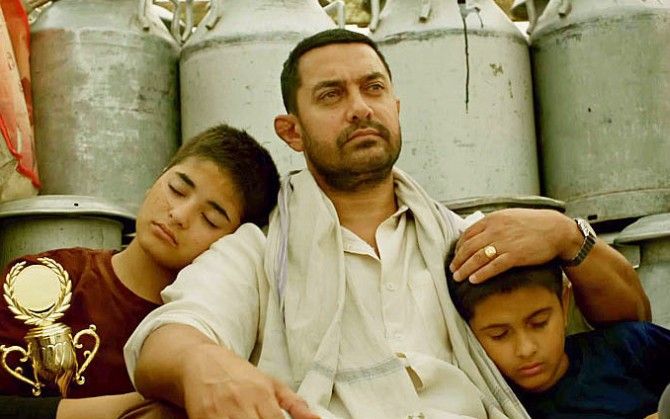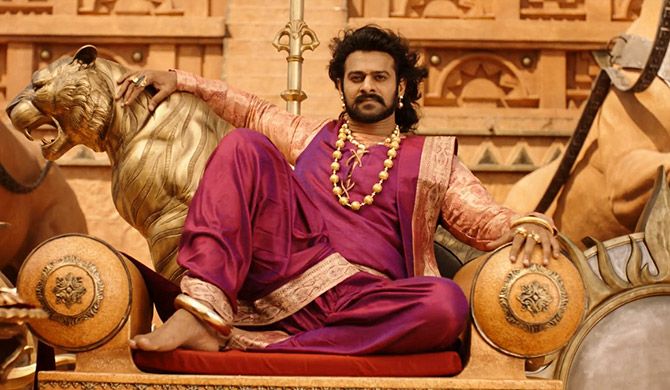'We need more universal films like Dangal, Sultan or Padmavat that work across single screens and multiplexes.'
Vanita Kohli-Khandekar reports.

IMAGE: Katrina Kaif shoots for Zero, co-starring Shah Rukh Khan. Photograph: Kind courtesy Katrina Kaif/ Instagram
Yash Raj Films' Thugs of Hindostan, starring Amitabh Bachchan and Aamir Khan, is the story of a gang of thugs who posed a challenge to the British Empire in India between 1790 and 1805; Vidhu Vinod Chopra Productions' Sanju, starring Ranbir Kapoor, is based on the life of actor Sanjay Dutt; Red Chillies Entertainment's Zero tells the story of a dwarf-sized man played by Shah Rukh Khan in love with the actress Katrina Kaif; and Zee Studios' Manikarnika: The Queen of Jhansi is a biopic based on the eponymous queen played by Kangana Ranaut.
These among a dozen big releases in 2018 offer hope to India's Rs 142 billion film industry pulverised by stagnating box office revenues and falling ticket sales.
They are what Akshaye Rathi, director, Saroj Screens, calls, "Tent pole films." His firm owns and operates 17 single-screen theatres across Central India.
"Single screens in small towns are starved of content. They survive only on tent pole films. We need more Hiranis, Rajamoulis and Rohit Shettys, who can do a mass film," says he.
Rajkumar Hirani has delivered several mass hits -- from the Munnabhai series to PK and 3 Idiots.
S S Rajamouli's Baahubali I and II are among the highest grossing Indian films, and the prolific Rohit Shetty is known for mass entertainers such as Singham, the Golmaal series (four so far) and Chennai Express, among others.

IMAGE: Aamir Khan with Zaira Wasim and Suhani Bhatnagar in Dangal.
"Admissions (ticket sales) have been declining for the last few years and are less than half of that at their peak. The only way growth is happening is through rising ticket prices, but that has driven half the people out of theatres," says Ajit Andhare, chief operating officer, Viacom18 Motion Pictures.
Last year, ticket sales across India are estimated at under a billion, from a peak of 2.5 billion a decade back.
Going by the Indian Readership Survey data, the cinema going habit has been falling steadily.
The biggest Hindi hits, say Dangal or Baahubali II, get just 3 to 5 per cent of all Indians into the theatre.
The lack of screens, high GST and rising costs are some of the reasons India's iconic film industry is in trouble.
But the biggest reason, say people across the value chain in production, distribution and exhibition, is the 'multiplex skew.'
"We need more universal films like Dangal, Sultan or Padmavat that work across single screens and multiplexes," says Rajesh Mishra, CEO, UFO Moviez.
UFO has digitised over 5,100 theatres and has its finger firmly on the pulse of the single-screen market.
"Nine out of 10 scripts that come to us for testing are with a multiplex audience in mind. Writers do not have the ability to write for single screens; a bulk of them are from a cosmopolitan/Western mind set, so content is more metro skewed," says Shailesh Kapoor, CEO, Ormax Media, a consulting firm.
"There are exceptions such as Tanu Weds Manu, but the (Hindi) film industry has given up on the single screen market and that is the problem," he adds.
He points to Tamil and Telugu cinema.
In average ticket price and net box office collections each of these amass half or less than the earnings for Hindi movies.

IMAGE: Prabhas in Baahubali.
However, on ticket sales, occupancy and margins they do better, making for a healthier industry.
Going by Ormax data in 2017, Telugu films sold 240 million tickets against 248 million for Hindi, which is spoken by six times as many people.
One big reason Telugu and Tamil cinema do well, say analysts, is the dominance of single screens and the poor penetration of multiplexes in Andhra Pradesh and Tamil Nadu.
That has meant film-makers keep churning out universal hits like Mersal (Tamil) or Khaidi No 150 (Telugu) in 2017.
From 2000 onwards, corporatisation brought organised finance and a more process-oriented approach for the Hindi film business.
Much of this was led by the growth of multiplexes which brought order to a fragmented business where revenue leakage was endemic.
Over the years, however, they had some unintended consequences.
The first is a revenue skew.
Over 2,000 of the 9,000 screens India has are in multiplexes owned by five major companies. These are easier to enter into a deal with than the 7,000 individual screen owners. They offer better revenue shares on a higher average ticket price.
More than 60 per cent of the Hindi industry's revenues come from multiplexes. This commercial dominance means films are being written largely for this audience.
And that is the second consequence.

IMAGE: Ayushmann Khurrana and Yami Gautam in Vicky Donor.
Multiplexes allow for lots of segmentation, helping films such as Vicky Donor (about a sperm donor) or Piku (about an old man's trouble with constipation) find their audience.
But these films don't yet work in, say, Kanpur or Vadodara.
About 20 years back, a Hindi film had to work across India to be profitable. Now a release in 800 to 1,000 (multiplex) screens, television and online rights is all it needs.
Rathi reckons that almost 90 per cent of the 300-odd Hindi films cannot be released in single screens and small towns.
Fewer universal Hindi films has meant dropping footfalls that has lead to theatres shutting down at an alarming rate.
"Tamil Nadu and Andhra Pradesh have nourished the (single screen) audience and kept them coming. It is very tough now to build the Hindi audience again," says Rathi.
"What we need is more high-concept movies which make it imperative to go to the theatre -- Bareilly Ki Barfi, Hindi Medium or Shubh Mangal Savdhan, something that pulls," says Siddharth Roy-Kapur, president, Film and Television Producers Guild of India.
Many years ago, Hollywood went through a similar crisis and discovered that large spectacle films, with super-heroes, aliens, sci-fi or snazzy computer graphics and sequels were the answer.
While India has done the odd Baahubali, "we can't match Hollywood budgets for spectacle," says Kapoor.
Besides, spectacle films such as Padmavat or Manikarnika sourced from Indian mythology are becoming a pain to make and release as hyper conservatism grows.
That leaves the universal Hindi hit in difficult territory between an audience that watches Golmaal Again (a bawdy comedy) and Newton (on elections in the Naxal belt).
To find the lowest common denominator will take creative calisthenics that very few film-makers in India are capable of.













 © 2025
© 2025